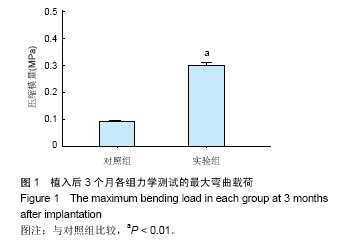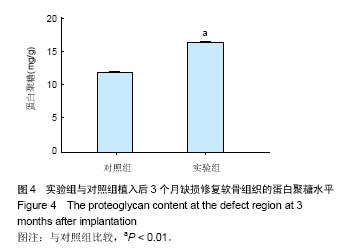中国组织工程研究 ›› 2018, Vol. 22 ›› Issue (6): 840-845.doi: 10.3969/j.issn.2095-4344.0056
• 组织工程骨及软骨材料 tissue-engineered bone and cartilage materials • 上一篇 下一篇
聚乳酸/聚羟基乙酸共聚物支架复合骨形态发生蛋白2基因增强的脂肪干细胞促进软骨缺损修复
阮世强,邓 江,鄢 陵,黄文良
- 遵义市第一人民医院骨科三病区,贵州省遵义市 563003
Polylactic acid/polyglycolic acid copolymer scaffolds carrying bone morphogenetic protein 2 gene enhanced adipose-derived stem cells promote cartilage defect repair
邓江,主任医师,硕士生导师,遵义市第一人民医院骨科三病区,贵州省遵义市 563003
- Ruan Shi-qiang, Deng Jiang, Yan Ling, Huang Wen-liang
摘要:
文章快速阅读:
.jpg)
文题释义:
聚乳酸/聚羟基乙酸共聚物:是一种新的可用于人体组织工程的适合成骨的支架材料,为多聚阳离子型的基因载体,是转基因效率相对较高的一种非病毒载体。聚乳酸/聚羟基乙酸共聚物来源广泛,获取容易且可大批量生产,其生物相容性和力学特征优良,具有稳定的三维立体结构,可根据需求调节材料的空间结构、形态、机械强度及降解时间。
基因增强的组织工程技术:利用基因工程技术将编码特定功能因子的目标基因(如可诱导成骨的诱导基因)转移到具有成骨或分化成骨潜能的种子细胞上,种子细胞和支架材料经体外复合后植入缺损组织,使其能在体内表达,促进种子细胞增殖和分化、降低异体免疫性、促进血管化,利用新生骨组织达到修复骨软骨缺损目的。
背景:基因增强的组织工程技术可促进种子细胞的增殖和分化,降低异体免疫性,促进血管化,利于骨软骨缺损的修复。
目的:观察双层聚乳酸/聚羟基乙酸共聚物支架材料复合慢病毒介导人骨形态发生蛋白2转染的兔脂肪干细胞修复骨软骨缺损的效果。
方法:取30只雄性新西兰大白兔,制作双侧股骨关节软骨缺损模型,随机分2组干预,实验组(n=15)于骨缺损处植入骨形态发生蛋白2增强的脂肪干细胞-双层聚乳酸/聚羟基乙酸共聚物支架复合体,结合Mosaicplasty组织工程学技术将自体软骨组织用于填充骨软骨柱间隙;对照组(n=15)植入脂肪干细胞-双层聚乳酸/聚羟基乙酸共聚物支架复合体,结合Mosaicplasty组织工程学技术将自体软骨组织用于填充骨软骨柱间隙;植入后3个月,取缺损处骨修复组织,进行生物力学及蛋白聚糖水平检测;植入后3,6,12个月,取缺损处骨修复组织,进行组织形态学观察。
结果与结论:①植入后3个月,实验组压缩模量、蛋白聚糖水平均高于对照组(P < 0.01);②对照组植入后3-12个月的缺损关节表面、颜色、形态及组织学形态均无任何明显变化;与对照组相比,实验组植入后3,6,12个月的缺损关节表面变得光滑,颜色变浅,有透明软骨样组织形成,缺损均有不同程度的愈合,且随着植入后时间的增加,上述变化趋势越来越明显;③结果表明,双层聚乳酸/聚羟基乙酸共聚物支架复合骨形态发生蛋白2基因增强的脂肪干细胞可显著促进骨软骨缺损的修复。
中图分类号:




.jpg)